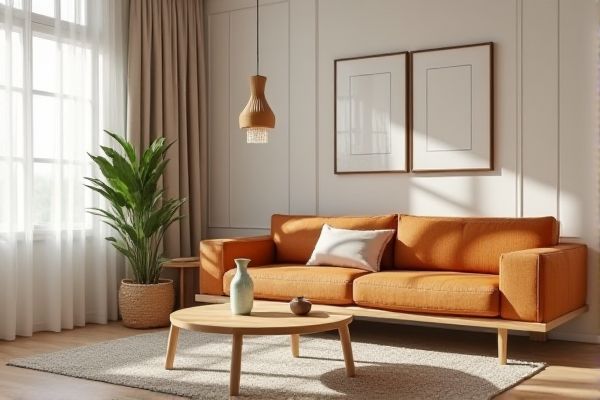
Fiberboard furniture offers a smooth surface ideal for painting and cost-effective designs, while plywood furniture provides superior strength and durability due to its layered wood construction. Explore the rest of this article to discover which option best suits your furniture needs and lifestyle.
Table of Comparison
| Feature | Fiberboard Furniture | Plywood Furniture |
|---|---|---|
| Material Composition | Compressed wood fibers bonded with resin | Thin layers of wood veneer glued crosswise |
| Durability | Moderate; prone to moisture damage | High; resistant to warping and splitting |
| Cost | Low; budget-friendly option | Higher; more expensive than fiberboard |
| Weight | Heavier than plywood | Lightweight; easier to handle |
| Finish | Smooth surface; requires lamination or painting | Natural wood grain visible; can be stained or varnished |
| Moisture Resistance | Low; absorbs water and swells | Better; plywood with waterproof glue resists moisture well |
| Structural Strength | Lower; suitable for light furniture | High; suitable for heavy-duty furniture |
| Environmental Impact | Uses recycled wood fibers; moderate impact | Uses solid wood veneers; higher impact but more durable |
Introduction to Fiberboard and Plywood Furniture
Fiberboard furniture is crafted from wood fibers bonded with resin and compressed into sheets, offering a smooth finish ideal for painted surfaces. Plywood furniture is made by layering thin wood veneers with the grain alternated for enhanced strength and durability, making it suitable for structural applications. Your choice between fiberboard and plywood furniture depends on the desired balance of cost, appearance, and long-term resilience.
Material Composition: Fiberboard vs Plywood
Fiberboard furniture consists of engineered wood made from wood fibers bonded together with resin under heat and pressure, offering a smooth, uniform surface ideal for painting and laminating. Plywood furniture is constructed from multiple layers of thin wood veneers glued together with alternating grain directions, providing superior strength and resistance to warping. Your choice between fiberboard and plywood hinges on the balance between cost-effectiveness and durability required for your furniture needs.
Strength and Durability Comparison
Fiberboard furniture typically lacks the strength and durability of plywood furniture due to its composite material made from wood fibers bonded with resin under heat and pressure. Plywood is constructed from thin layers of wood veneer glued together with the grain of each layer perpendicular to the next, providing superior structural integrity and resistance to warping or cracking. When choosing furniture, Your decision should consider that plywood offers better load-bearing capacity and longevity compared to fiberboard, making it ideal for items subjected to frequent use or heavy weight.
Aesthetic Appeal and Surface Finish
Fiberboard furniture offers a smooth, uniform surface ideal for veneers and laminates, providing a sleek and consistent aesthetic appeal, while plywood furniture showcases natural wood grain patterns that enhance its visual warmth and character. The surface finish of fiberboard tends to be highly durable and resistant to warping, making it suitable for modern, minimalist designs, whereas plywood's textured finish allows for more rustic or traditional styles with visible knots and layers. Choosing between fiberboard and plywood depends on the desired balance between refined finishes and authentic wood appearance in furniture design.
Weight and Workability Factors
Fiberboard furniture is generally lighter than plywood furniture due to its composite material composition, making it easier for You to move and handle. Its smooth surface enhances workability, allowing for precise cuts and finishes, whereas plywood's layered structure offers greater strength but can be heavier and more challenging to shape. Choosing between fiberboard and plywood impacts the weight and ease of customization in Your furniture projects.
Environmental Impact and Sustainability
Fiberboard furniture generally has a lower environmental impact due to its use of wood fibers and recycled materials, reducing the demand for solid wood and conserving natural forests. Plywood furniture, although stronger and more durable, often requires the use of formaldehyde-based adhesives that can emit volatile organic compounds (VOCs), affecting indoor air quality and environmental health. Sustainable choices favor fiberboard with low-emission adhesives and certifications like FSC or CARB, promoting responsible forestry and reduced carbon footprint compared to traditional plywood options.
Cost-effectiveness and Budget Considerations
Fiberboard furniture typically offers greater cost-effectiveness due to lower material and manufacturing expenses compared to plywood furniture. Plywood furniture, while pricier, provides enhanced durability and strength, making it a worthwhile investment for long-term use. Your budget considerations should balance initial affordability with the potential need for replacement or repairs over time.
Moisture Resistance and Longevity
Fiberboard furniture generally exhibits lower moisture resistance compared to plywood, as its engineered wood fibers tend to absorb water, leading to swelling and potential deformation over time. Plywood's layered construction, with its cross-grain veneers, provides enhanced durability and better resistance to moisture, resulting in longer-lasting furniture in humid environments. Choosing plywood furniture is advisable for spaces prone to dampness due to its superior longevity and sustained structural integrity.
Common Applications and Use Cases
Fiberboard furniture is commonly used in budget-friendly interior pieces such as cabinets, shelves, and office desks due to its smooth surface and ease of finishing. Plywood furniture excels in structural applications like bed frames, dining tables, and outdoor furniture, thanks to its strength, durability, and resistance to warping. Your choice depends on whether you prioritize cost-effectiveness and a polished look (fiberboard) or robustness and longevity (plywood).
Choosing the Right Option for Your Needs
Fiberboard furniture offers affordability and smooth surfaces ideal for painted finishes, making it suitable for lightweight, budget-conscious projects. Plywood furniture provides superior strength, durability, and resistance to moisture, preferred for high-traffic or load-bearing applications like cabinetry and structural pieces. Selecting between fiberboard and plywood depends on usage requirements, budget constraints, and desired longevity.
 homyna.com
homyna.com